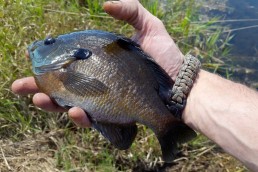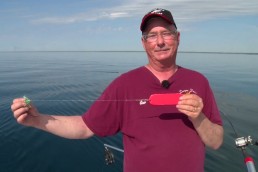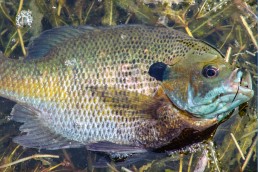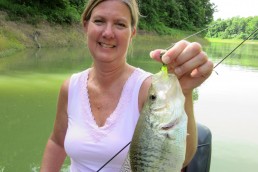Spring is the Time for Big Bluegills
SHARE THIS POST
Bluegill fishing finds a lot of anglers on the water and even on the ice all year long. Drilling holes through the ice and catching winter bluegills may not be every angler’s cup of tea. For those of us who would prefer to catch fish from open water rather than through a big ice cube, I have good news—spring is right around the corner.
This is the time of the year to catch big bluegills because they move to the shallows to spawn and are aggressive. Once water temperatures reach 75 degrees, bluegills begin the spawn. This, along with finding their shiny, bowl-shaped beds close to shore in very shallow water, is one of the best ways to know spawning has begun. This happens around the last week of May here in Illinois. Fish two weeks before and after the last week of May and you should hit the best spawning fishing there is.
Fishing for bluegills guarding their nest is nothing less than a blast. One of the best techniques is to “walk the shoreline” or boat within casting distance of their beds and use a small lure or bait just below a small bobber. Cast your bait beyond the bed and slowly retrieve it through the beds. Depth of the beds determines how deep to set the bobber. Fish close to the bottom and keep both the lure and bobber as small as you can, and set the hook fast, otherwise the big males will swallow the hook.
Largemouth bass and crappies will spawn before bluegills. And it is not uncommon to find bluegills still spawning in June as they wait for the water to continue to warm up.
Before the spawn, look for them near the shores of ponds and lakes in water less than 6 feet deep, where they are building nests in preparation for the aforementioned spawn. Bluegills will then quickly move into that area and overpopulate it. This is particularly true if there is any cover nearby such as weeds, stumps, brush or treetops.
If the bluegills aren’t biting, move. Bluegills group together during the spawn, and if you have fished a location for any amount of time without catching one, chances are these fish are not there and you are wasting your time. Make the move, whether by walking or moving your boat, until you find bluegills. You might “luck” into a bluegill from time to time anywhere on the water, but during the spawn, a good location will produce almost non-stop action.
Are you enjoying this post?
You can be among the first to get the latest info on where to go, what to use and how to use it!
In the springtime, bluegills are not particularly fussy about what they will attack and consume. The best baits for bluegill are nightcrawlers, earthworms and mealworms. Waxworms and crickets will also cause a bluegill to bite.
To catch one after another, hook your red worm, mealworm, nightcrawler, earthworms, etc., on the hook underneath a small-sized bobber. The male bluegills build beds, and they feel responsible for protecting it from other intruders. For that reason, 95 percent of the fish caught off beds will be big males. The females normally hang out in deeper water on the backside of the nests. They are best caught by casting beyond the area with a lure and slowly retrieving it in.
Spinnerbaits are good when fished slowly and on waters you are not familiar with. It does not take a large spinner to intrigue a bluegill to bite. A 1/32-ounce lure is all it takes to entice a bite.
One of the biggest mistakes made is making too much noise. Smaller fish tolerate some noise, but the big ones will not. Do not bang your poles, drop your tackle box or even talk loud and you will catch more, bigger bluegills.
Last but not least, go “light.” Big bluegills are more likely to just barely tap your bait than produce a pounding strike. That being said use lightweight gear, especially a rod with a soft, sensitive tip. This will enable you to barely lift your pole and notice a slight bend on the tip of your rod showing a fish has taken your bait and has become hooked. Also, stick with 1- or 2-pound-test line to catch more, bigger bluegills.
Spring bluegills are often aggressive biters. Try to keep your presentation as small as you can. Earthworms are a good choice for bluegills.
MWO
SHARE THIS POST
Did you enjoy this post?
You can be among the first to get the latest info on where to go, what to use and how to use it!
Jason Houser
Jason Houser is an avid outdoorsman from Central Illinois. Houser has been a full-time freelance writer since 2008. He is also the host of Jason Houser Outdoors, airing on the Hunt Channel. He can be found on Facebook at Jason Houser Outdoors or on the web at jasonhouseroutdoors.com.



